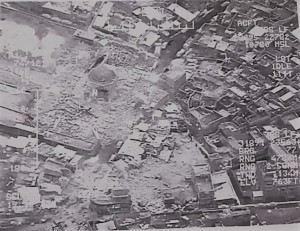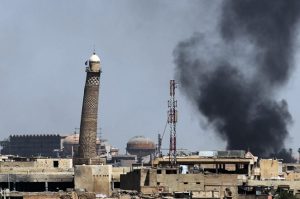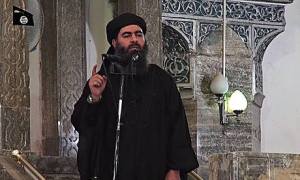nsnbc : The Islamic State and the United States exchanged accusations for the destruction of the minaret of the Grand Al-Nuri Mosque in Mosul on Wednesday. Meanwhile, a senior Iraqi counter-terrorism commander said the mosque and the minaret had been rigged with explosives while Iraqi Prime Minister Haider al-Abadi said in a statement by his office that Islamic State militants, by resorting to blowing up the historic site, were officially declaring their defeat.
 U.S. Army Major General Joseph Martin, who leads the U.S.-led coalition’s combined joint forces land component, described the destruction of the Grand al-Nuri Mosque of Mosul and its famous leaning minaret “a crime against the people of Mosul and all of Iraq.” He stated that “The responsibility of this devastation is laid firmly at the doorstep of ISIS.”
U.S. Army Major General Joseph Martin, who leads the U.S.-led coalition’s combined joint forces land component, described the destruction of the Grand al-Nuri Mosque of Mosul and its famous leaning minaret “a crime against the people of Mosul and all of Iraq.” He stated that “The responsibility of this devastation is laid firmly at the doorstep of ISIS.”
The self-proclaimed Islamic State (ISIS / ISIL / Daesh), for its part, circulated a statement blaming the U.S.-led coalition’s warplanes for bombing the minaret. The ISIS news outlet Amaq mirrored the statement that was circulated in the few remaining ISIS-held pockets in Mosul, from where it was disseminated. It was from the medieval Gran Al-Nuri Mosque with its leaning minaret, that Abu Bakr al-Baghdadi (a.k.a. Al-Badri or Caliph Ibrahim) proclaimed the Islamic Caliphate three years ago.
The Iraqi Ministry of Defense distributed a photo taken from the air that appears to show the mosque and the minaret flattened to rubble in the middle of small houses in the historic Old City of Mosul where some few hundred ISIS fighters continue their resistance against Iraqi and coalition forces. Thousands of civilians are trapped there along with ISIS, and casualties of non-combatant civilians are mounting. nsnbc received reports from Mosul, according to which infighting between civilians who support and civilians who oppose ISIS has broken out as well.
 Abdul-Ghani al-Assadi, commander of the Iraqi army’s elite Counter-Terrorism Service, said in a press statement that the Grand Nuri al-Kabir Mosque and its famous Hadbaa (leaning) Minaret had already been prepared for detonation once the group reached “total bankruptcy” as he put it. Assadi said it had been Islamic State’s habit to detonate historic sites in Mosul, reminding that the militants had previously blown up the Nabi Yunis shrine in Mosul.
Abdul-Ghani al-Assadi, commander of the Iraqi army’s elite Counter-Terrorism Service, said in a press statement that the Grand Nuri al-Kabir Mosque and its famous Hadbaa (leaning) Minaret had already been prepared for detonation once the group reached “total bankruptcy” as he put it. Assadi said it had been Islamic State’s habit to detonate historic sites in Mosul, reminding that the militants had previously blown up the Nabi Yunis shrine in Mosul.
The minaret’s collapse came as CTS forces were 50 meters away from the mosque, partaking in an invasion by U.S.-backed Iraqi joint forces of the Old City, the ancient neighborhood where a few hundreds of IS members are entrenched as a last refuge in Mosul. Iraqi officials had privately expressed the hope that the mosque could be captured in time for Eid al-Fitr, the festival marking the end of Ramadan, the Muslim fasting month. The first day of the Eid falls this year on June 25 or 26 in Iraq.
The fall of Mosul would mark the final phases or the end of the Iraqi half of the “caliphate” even though Islamic State would continue to control territory west and south of the city, the largest they had control of in both Iraq and Syria. Al-Baghdadi has according to senior US and Iraqi military intelligence sources left Mosul and is believed to be hiding in the border area between Iraq and Syria.
 The mosque is named after Nuruddin al‑Zanki, a noble who fought the early crusades from a fiefdom that covered territory in modern-day Turkey, Syria and Iraq. The mosque was built in 1172-73, shortly before his death, and housed an Islamic school. By the time renowned medieval traveler Ibn Battuta visited two centuries later, the minaret was already leaning. Its tilt gave the landmark its popular name – al-Hadba, or the hunchback.
The mosque is named after Nuruddin al‑Zanki, a noble who fought the early crusades from a fiefdom that covered territory in modern-day Turkey, Syria and Iraq. The mosque was built in 1172-73, shortly before his death, and housed an Islamic school. By the time renowned medieval traveler Ibn Battuta visited two centuries later, the minaret was already leaning. Its tilt gave the landmark its popular name – al-Hadba, or the hunchback.
The minaret was built with seven bands of decorative brickwork in complex geometric patterns ascending in levels towards the top in designs also found in Persia and Central Asia. Nabeel Nouriddin, a historian and archaeologist specializing in Mosul and its Nineveh region, said the minaret has not been renovated since 1970, making it particularly vulnerable to blasts even if it was not directly hit.
CH/L -nsnbc 22.06.2017
Source Article from https://nsnbc.me/2017/06/22/us-isis-exchange-accusations-for-destruction-of-mosuls-grand-al-nuri-mosque/
 RSS Feed
RSS Feed















 June 22nd, 2017
June 22nd, 2017  Awake Goy
Awake Goy 










 Posted in
Posted in  Tags:
Tags: 













